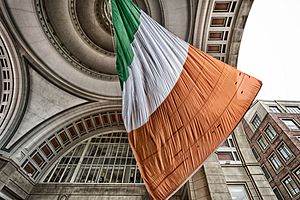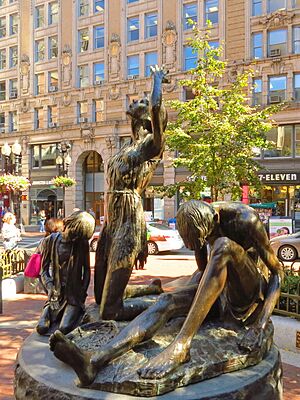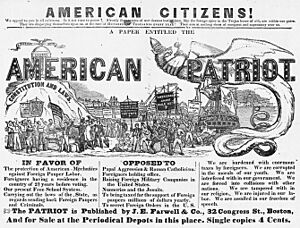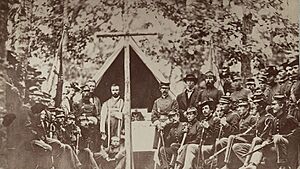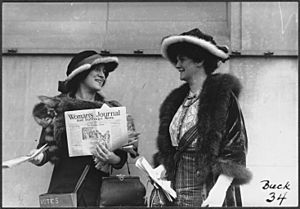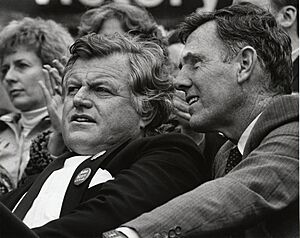History of Irish Americans in Boston facts for kids
People of Irish descent make up the largest group of people from one background in Massachusetts, and one of the biggest in Boston. Boston used to be a city mostly settled by Puritans. But in the 1800s, it changed a lot as many immigrants arrived from other parts of the world. The Irish were the first large group to come during this time, especially after the terrible Great Irish Famine. Their arrival helped change Boston from a mostly English Protestant city into a more diverse place.
At first, the Irish were often hired as workers and servants, but they didn't mix much with the older residents. In the 1840s and 1850s, a group called the Know Nothing movement, which was against Catholics and immigrants, targeted Irish Catholics in Boston. However, in the 1860s, many Irish immigrants bravely fought for the Union in the American Civil War. This show of loyalty helped reduce some of the unfair feelings against them.
As their population grew, and with strong community ties and local political groups, the Irish eventually gained political power in Boston. The older, established families (often called "Yankees") continued to lead in finance, business, and higher education. The Irish left their mark on the area in many ways: in neighborhoods like Charlestown and South Boston that are still very Irish; in the name of the local basketball team, the Boston Celtics; in the famous Irish-American political family, the Kennedys; in many important local politicians, like James Michael Curley; and by helping to create Boston College, a Catholic university.
Contents
Boston's Irish History
Early Arrivals
Irish Catholics have been in Boston since the early days of the American colonies. Many arrived as indentured servants, meaning they worked for a period of time to pay for their journey. In 1654, a ship called the Goodfellow brought many Irish immigrants who were "sold" into this service.
Most early Irish arrivals were Presbyterians from a part of Ireland called Ulster. They came seeking relief from high rents and taxes. They were careful around Boston's English Puritans, who were not friendly to the Irish. Many moved to areas outside the main colony and started towns like Londonderry in New Hampshire. The few Irish Catholics who settled in Boston had to hide their faith or change it, because Catholicism was against the law. Some Irish immigrants even came to Boston unwillingly, after being captured by pirates.
On March 17, 1737, a group of Irish Protestants in Boston formed the Charitable Irish Society. Its goal was to help Irish immigrants who were old, sick, or in need. This meeting was the first known celebration of St. Patrick's Day in the American colonies. This society still exists today and is the oldest Irish organization in North America.
After the Irish showed their loyalty by fighting in the American Revolutionary War, they were more accepted in Boston. Many Irish Americans fought in the Battle of Bunker Hill. One son of Irish immigrants, John Sullivan, became a general under George Washington. It's said that Sullivan used "Saint Patrick" as the secret password when his troops entered Boston after the British left in 1776. Boston still celebrates this event every year on Evacuation Day, which is also Saint Patrick's Day.
The 1800s: A New Wave
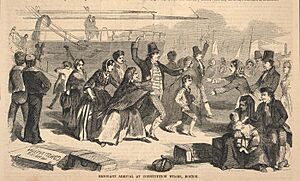
A new wave of Irish immigration to Boston began in the 1820s. At first, many were Protestants, but more and more Catholics joined them. From the start, there were challenges. Catholics were seen as a threat, and local people reacted strongly. Groups of angry Protestants damaged property in Irish neighborhoods. Preachers spoke out against Catholicism, and newspapers printed untrue stories about them.
On July 11, 1837, a fight broke out between Yankee firemen and an Irish funeral procession on Broad Street. It quickly grew into a huge riot involving about 800 men, with 10,000 watching. The mayor had to call in the state militia to stop it. No one was killed, but three Irishmen were sent to jail. This event became known as the Broad Street Riot.
The Famine Years
The Port of Boston became a major entry point for immigrants during the Great Irish Famine (1845–1852). By 1850, the Irish were the largest ethnic group in Boston. Most of these immigrants were poor, unskilled workers from farms. They settled in crowded areas like the North End and South Cove. Many were not only poor but also sick with typhus from the "coffin ships" that brought them. To control the spread of disease, a hospital was built on Deer Island, where many immigrants died. A cholera outbreak in 1849 also hit the Irish poor hard, killing over 500 people.
Many Irish women became domestic servants; by 1860, two-thirds of Boston's servants were Irish. Most Irish men worked in construction, in quarries, or on the docks. Irish laborers helped build the business district, townhouses on Beacon Hill, and filled in land for the South End.
One important person was Andrew Carney. He was born poor in Ireland, became a successful tailor in Boston, and later became a leader in finance. He helped start the First National Bank of Boston and the John Hancock Insurance Company. He also helped found Boston College and, in 1863, started Carney Hospital. He insisted that the hospital welcome "the sick without distinction of creed, color or nation."
The Boston Irish Famine Memorial was built in 1998 on the Freedom Trail. It has two bronze sculptures: one shows a starving woman and her children, and the other shows hopeful figures arriving in Boston.
The Know Nothings
In the 1840s and 1850s, growing anti-immigrant and anti-Catholic feelings led to the Know Nothing movement. In 1854, the Know Nothings gained control of the Massachusetts legislature. They passed laws that made it harder for Catholics. For example, they tried to stop Catholics from being buried in public cemeteries and made children read from the Protestant Bible in public schools. They even raided Catholic schools and convents. The first Irish police officer in Boston, Bernard "Barney" McGinniskin, was fired that year without a good reason.
In Boston's public schools, Catholic children had to say Protestant prayers. In 1859, a Catholic boy who refused to say the Protestant version of the Ten Commandments was badly beaten. This led to the Eliot School rebellion, where over 300 boys left the school.
The Civil War
Many Irish immigrants fought for the Union in the Civil War. This included Colonel Thomas Cass, who led an Irish regiment called the Fighting Ninth. Sister Mary Anthony O'Connell served as a nurse on the front lines and was known as the "Angel of the Battlefield." Irish Bostonians also helped the war effort by working in factories and shipyards. However, in 1863, a riot broke out among some Irish Catholics in the North End who were against the military draft.
By 1870, Boston had 250,000 residents, and 56,900 of them were Irish. Around this time, powerful Irish political leaders, known as "ward bosses," became important. These bosses, like Martin Lomasney and John F. Fitzgerald, helped their neighbors by providing food, clothing, and shelter. This system, called patronage, helped the Irish rise out of poverty. In 1884, Boston elected its first Irish mayor, Hugh O'Brien.
As Irish Americans gained political power, some anti-Catholic groups became active again. They tried to stop Catholic schools from being recognized. In response, Catholics built more of their own schools. By the end of the century, areas like South Boston and Charlestown were mostly Irish.
The 1900s: New Roles
In the early 1900s, Irish Americans in Boston became very successful in Democratic Party politics and the labor movement. Many became teachers, police officers, firefighters, nurses, and clerks. They often chose jobs that offered security and pensions.
Few Irish women in Boston were active in the suffrage movement, which was mostly led by upper-class women. Margaret Foley was a rare exception. Most working-class women were more interested in workers' rights. Mary Kenney O'Sullivan helped start the Women's Trade Union League in 1903. Julia O'Connor led a successful telephone operators' strike in 1919. That same year, the Boston Police went on strike for better pay. Most of the officers who lost their jobs were Irish Catholics.
During this time, the Irish sometimes had disagreements with Italians, even though both groups were mostly Catholic and Democratic. The two groups competed for jobs and housing.
Leading Politicians
One of the most important figures in Boston politics in the early 1900s was John F. Fitzgerald. He was so charming that people called him "Honey Fitz." As mayor, he improved the Port of Boston. Later, he taught his grandchildren about politics. One of them, John F. Kennedy, became the 35th president of the United States.
Fitzgerald was followed by another popular Irish American mayor, James Michael Curley. Curley came from a poor background. He was a natural speaker and learned a lot by studying speeches at the Boston Public Library. He served as mayor four times and also as Governor of Massachusetts. While some saw him as corrupt, he was loved by Boston's poor. During the Great Depression, he expanded the city hospital, improved the subway system, and built parks and schools. He was known for helping people directly.
Moving to the Suburbs
After 1945, many Irish Americans moved to the suburbs as they became more successful.
Boston's politics changed after the war. New government programs made the old system of political bosses less important. The election of President John F. Kennedy made Irish Americans in Boston very proud. A series of Irish mayors, like John Hynes and Kevin White, worked on city improvement projects. As families became more settled and moved to the suburbs, Boston's neighborhoods started to lose some of their strong ethnic identities.
In the 1970s, many working-class Irish residents in Boston were involved in the busing controversy. To fight segregation in schools, a judge ruled that students had to be bused between white and black areas. South Boston High School was a major site of protests. This plan led to more students dropping out and many white families moving to the suburbs or private schools.
In 1992, an Irish-American LGBTQ+ group was not allowed to march in the St. Patrick's Day parade in South Boston. The group went to court, but the Supreme Court ruled against them in 1995.
The 2000s
The Irish no longer control Boston politics as much as they used to, and they don't always vote for the Democratic Party. However, in Massachusetts, many Irish Americans still vote Democratic.
Irish Culture in Boston
Religion

Most Irish immigrants who came to Boston in the 1800s were Roman Catholic. The Catholic Church played a very important role in helping the poor. While other charities existed, they sometimes tried to change people's religion. To avoid this, Catholics built their own orphanages, homes for teens, and a hospital (Carney Hospital). The Catholic St. Vincent de Paul Society offered food, shelter, and advice. Irish Catholics also built their own schools. By 1917, they had 29 elementary schools, four high schools, and Boston College.
The first Catholic church in Boston was the Holy Cross Church, built in 1803. The Roman Catholic Archdiocese of Boston was created in 1808. John Bernard Fitzpatrick, the son of Irish immigrants, became the first Irish-American Bishop of Boston in 1846. Irish Americans eventually became very important in the Catholic Church in Boston.
Media
The Pilot, started in 1829, is the official newspaper of the Archdiocese of Boston. It was founded when many Irish immigrants were arriving. It had a section to help people find missing friends and shared news from Ireland.
The Boston Irish Reporter, started in 1990, is a monthly newspaper for Irish Americans.
Arts and Entertainment

In the mid-1900s, when Roxbury was an Irish neighborhood, thousands of Bostonians went to dance halls to enjoy traditional Irish music. Even though the dance halls are gone, Irish music is still important in Boston. Many Celtic punk bands, like Dropkick Murphys, started in Boston. BCMFest is Boston's yearly Celtic Music Festival, featuring local musicians. Many Boston pubs also have live Irish music. Boston hosted the World Irish Dancing Championships in 2013.
Edwin O'Connor's 1956 novel, The Last Hurrah, is about a city much like Boston. Its main character, Frank Skeffington, is thought to be based on James Michael Curley. A movie was made from the book in 1958. Other movies about Boston Irish life include Good Will Hunting (1997) and The Departed (2006).
Rugby is popular with the Irish community in Boston. The Boston Irish Wolfhounds rugby team was founded in 1989. Boston also has teams for hurling and Gaelic football, which are traditional Irish sports. In other sports, Irish Bostonians started the Royal Rooters, a Boston Red Sox fan club. And "Lucky the Leprechaun," the mascot of the Boston Celtics, is a nod to Boston's large Irish population.
Demographics
People of Irish descent are the largest single ethnic group in Boston, making up 15.8% of the population in 2013. In 2014, Irish Americans made up 22.8% of the greater Boston area, which is the highest percentage among the 50 largest U.S. cities. Many towns south of Boston also have a high percentage of Irish residents. In 2010, the most Irish city in the U.S. was Scituate, Massachusetts, with 47.5% of its residents saying they had Irish ancestry.
Famous Irish Americans from Boston
- Ben Affleck (b. 1972), actor, filmmaker
- Casey Affleck (b. 1975), actor and director
- Andrew Carney (1794–1864), entrepreneur, philanthropist
- Ken Casey of Dropkick Murphys (b. 1969), musician
- Thomas Cass (1821–1862), Civil War colonel
- James Michael Curley (1874–1958), 35th mayor; served four terms
- Jane Curtin (b. 1946), actress and comedian
- Richard Cushing (1895–1970), Archbishop of Boston, Cardinal
- Joe Derrane (1930–2016), Irish accordionist
- Chris Evans (b. 1981), actor
- John F. Fitzgerald (1863–1950), 33rd mayor; mentor of John F. Kennedy
- Raymond Flynn (b. 1939), 43rd mayor; ambassador to the Holy See
- Margaret Foley (1875–1957), suffragist
- Ann Glover (?–1688), last person to be hanged as a witch in Boston
- The Kennedy family
- Denis Leary (b. 1957), actor, comedian
- Dennis Lehane (b. 1965), author
- Martin Lomasney (1859–1933), political boss
- Conan O'Brien (b. 1963), television host
- Hugh O'Brien (1827–1895), 27th mayor; first Irish mayor of Boston
- Sister Mary Anthony O'Connell (1814–1897), Civil War nurse
- Julia O'Connor (1890–1972), labor leader
- Amy Poehler (b. 1971), actress and comedian
- John L. Sullivan (1858–1918), heavyweight boxing champion
- Anne Sullivan (1866–1936), teacher of Helen Keller
- Maura Tierney (b. 1965), actress
- Maurice J. Tobin (1901–1953), 39th mayor; 56th Governor of Massachusetts, U.S. Secretary of Labor
- Donnie Wahlberg (b. 1969), actor and singer
- Mark Wahlberg (b. 1971), actor
- Marty Walsh (b. 1967), 45th mayor, U.S. Secretary of Labor
- Kevin White (1929–2012), 42nd mayor; served four terms
See also
- Eire Society of Boston
- Mayor of Boston
- Roman Catholic Archdiocese of Boston
- South Boston


